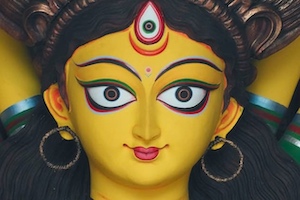Brush with a master
Telegraph | 8 March 2025Busy Bee, the AB Block-based multi-activity centre, hosted a workshop on Jamini Roy that brought out facets of the painter’s life that the participants had no inkling of. It was conducted by Vinitha, a Mumbai-based author who has published a critically acclaimed children’s book called Jamini Roy’s Unbroken Lines.
Vinitha shared Roy’s life story with the children and their parents who had gathered. She taught them to identify his signature style and had them give it a try too.
Struggle after success
The participants observed that a baked red was the common shade across Roy’s works, and Vinitha explained why.
“Jamini was born (in 1887) into a rich land-owning family with progressive parents. Not only would they mingle freely with people of different castes, but they also moved to a remote location in Bankura where the boy got to learn by observing peasants, potters, craftsmen…. Little Jamini drew and coloured all the time and the red he loved all his life was probably the colour of the laterite sand in Bankura,” she explained.
Back in the day, sons followed their fathers’ professions but Jamini’s parents let him do what he wanted. So while still a teenager, he was sent to Calcutta to learn art from the likes of Abanindranath Tagore. “Here he learnt the Western techniques of painting and while still in college, became famous for his portraits. He made portraits for the British officers’ wives, painted sari borders, wedding cards… But one day, he stopped it all and started patachitra,” Vinitha shared. “And it had no takers.”
Roy, who was minting money before this, was now struggling to pay rent. He was already married with kids by then and they got thrown to the streets. “The political scenario at the time was highly nationalistic and perhaps, he wanted his art to reflect his roots,” she says.
Roy was criticised for using folk art with Western techniques but that was his personal interpretation. “He was obsessed with cats, cows, birds, and mother-and-child themes. Hailing from Bankura, he also painted Bankura horses and Santhals. And he drew women with great dignity,” Vinitha said. “Almost all his works had borders. If not a traditional border, at least a motif of dots on a corner, probably inspired by the alpanas he would see his mother create.”
Roy almost starved for six years but would not return to portraits. He stuck with what made him happy, not necessarily successful. He would paint on his wife’s torn saris, on gunny bags of rice… And then one day, it all changed. His paintings started selling and, so well that, he would quote his price.
The man & money
In a world where artists often complain of lack of motivation, Roy woke up daily at 6am, prayed, kept a flower on his canvas, that was his god, and painted till noon.
“He had a strange relationship with money,” explained Vinitha. “He made a lot of money but continued to use a tattered wallet as he was superstitious. He priced his work modestly so that, like calendars, every house could have his art. But then once Indira Gandhi came over to buy his paintings and promised to send the money once she returned to Delhi, but he refused to part with them till the payment was cleared.”
Once Mahatma Gandhi had come to Calcutta and wanted to meet Roy but got busy. “His secretary asked Jamini to come meet him but the latter refused, saying it wouldn’t be possible to take his scrolls over to show him,” Vinitha said. “An art gallery from New York wanted to exhibit his works and promised to return any paintings that did not get sold. Again, Jamini refused, saying the gallery must buy all the paintings they took for the exhibition.”
Less is more
As he got older, Roy stopped using colour and turned to calligraphic line drawings. “He was inspired by his grandson’s art that had no colour but was still beautiful. The eyes of his figures were no longer drawn but the paintings were complete in themselves. The art was frugal, distilled, and graceful. He would use vegetable dyes and natural colours, which would fade but would gladly touch them up when buyers brought them back to him,” she said.
Vinitha also shared how Roy was criticised for letting his students paint in his style, which he’d simply sign and sell under his name. “People said he was churning out art like a factory, but he didn’t care,” she said.
Sharmistha Chatterjee, a lady who attended the workshop with son Ayushmaan, recalled with nostalgia how she was taught to draw the “Jamini Roy cat” in school. “Today there is much talk of digital art but artists need to first know their roots,” she said.
Another lady, Aritri Chakraborty had come with her daughter Aarini Nandy. “As a child I liked art but when my parents put me in art school, I got bored of the rigidity of it all. That’s what one learns from the life of Jamini Roy — how to break away from rules and do it your way. I also appreciate how unconventional his parents were to have given wings to such an artist,” she said.
The purpose of the workshop, Vinitha said, was to help, especially children, be unafraid of art. “For that, art has to be accessible to them. Once they know enough to, say, identify an artiste from his work, it gives the child agency.
There is nothing called ‘bad art’, but given how it is a graded subject in our schools, those who cannot draw form correctly are told off by teachers,” said the author whose books are taught in schools too. “What we learn from Jamini Roy’s story is that anyone who loves drawing should draw.”
